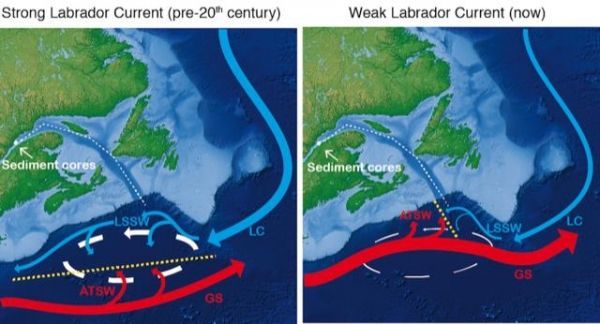The research co-led by Drs. Christelle Not and Benoit Thibodeau from the Department of Earth Sciences and the Swire Institute of Marine Science, The University of Hong Kong, highlights a dramatic weakening of the circulation during the 20th century that is interpreted to be a direct consequence of global warming and associated melt of the Greenland Ice-Sheet. This is important for near-future climate as slower circulation in the North Atlantic can yield profound change on both the North American and European climate but also on the African and Asian summer monsoon rainfall. The findings were recently published in the prestigious journal Geophysical Research Letters.
The Atlantic Meridional Overturning Circulation (AMOC) is the branch of the North Atlantic circulation that brings warm surface water toward the Arctic and cold deep water toward the equator. This transfer of heat and energy not only has direct influence on climate over Europe and North American but can impact the African and Asian monsoon system through its effect on sea surface temperature, hydrological cycle, atmospheric circulation and variation in the intertropical convergence zone. Many climate models predicted a weakening, or even a collapse of this branch of the circulation under global warming, partly due to the release of freshwater from Greenland Ice-Sheet. This freshwater has lower density than salty water and thus prevents the formation of deep water, slowing down the whole circulation. However, this weakening is still vigorously debated because of the scarcity of long-term record of the AMOC. Drs. Not and Thibodeau used microfossils, called foraminifer, found in a sediment core to estimate the past temperature of the Ocean. The sediment core used is located in the Laurentian Channel, on the coast of Canada, where two important currents meet. Thus, the strength of these currents will control the temperature of the water at the coring site which implies that the temperature reconstructed from this core is indicative of the strength of the North Atlantic circulation. With their collaborators from the United-States of America, they validated their results using instrumental data and two numerical models that can simulate the climate and the ocean.
Read more at The University of Hong Kong
Image: This is a schematic of the circulation in the western North Atlantic during episode of strong (left) and weak (right) westward transport of the Labrador Current (LC). The oceanography of this region is characterised by the interaction of water masses formed in the Labrador and moving westward (LC and Labrador Sea Slope Water (LSSW)) and the water masses moving eastward originating as the Gulf Stream (GS) and its Atlantic Temperate Slope Water (ATSW). The exact location where these two water mass systems meet (yellow dashed lines) is determined by the strength of the northern recirculation gyre (white arrows), which then control the temperature recorded by the foraminifers. The positions of the sediments cores is indicated by the white dot. (Credit: @The University of Hong Kong)


